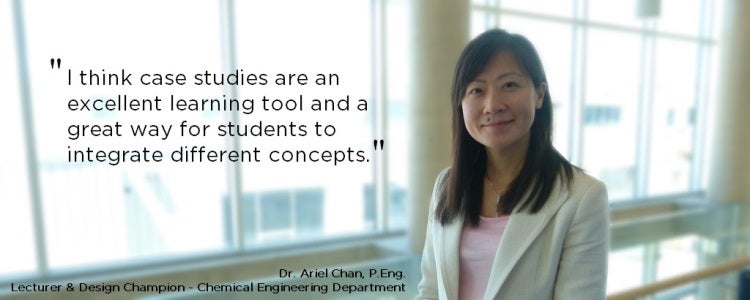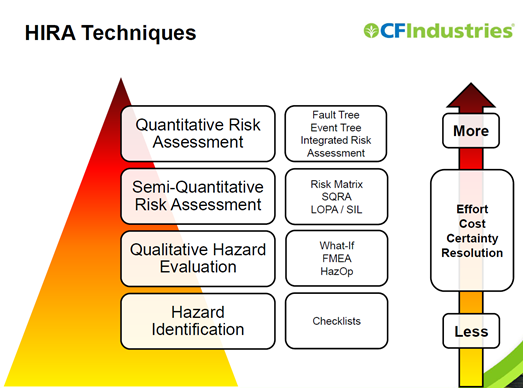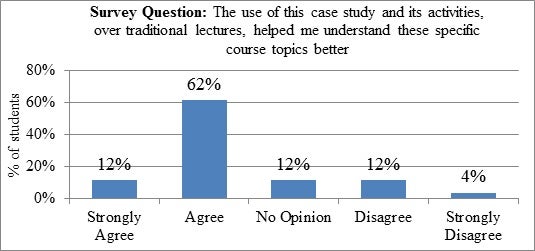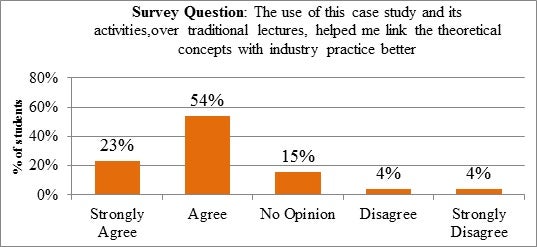
Process Analysis and Design (CHE 480) is a required course that focuses on design and selection of common process equipment, analysis of process flow sheets and inherently safer design principles.
Course Description
Typical Class Size: 70 students
This course already used case studies to integrate multiple concepts and provide real life applications related to course material. These cases were mostly focused on inherently safer design. For the past couple of years, a guest lecturer from industry was also brought in for one lecture on process safety.
Guest Lecture – Case Study Source
| Source Company | CF Industries |
|---|---|
| Initial Implementation Style | Traditional lecture style in a 3 hour class given by industry representative |
| Main Lecture Topic | Process Hazard Analysis for relocation of two natural gas regulators |
The guest speaker, Luke Kittmer, works at CF Industries as a Process Safety Engineer. The company is a global leader in nitrogen fertilizer manufacturing and distribution. For the past couple of years, Luke was invited to give a presentation on process safety related to practices at CF Industries.
Luke’s presentation included:
- Examples of catastrophic incidents to emphasize the importance of process safety
- Hazard Identification and Risk Assessment (HIRA) and respective techniques
- A real design problem that his chemical plant was faced with as well as the solution that his safety team employed (for the relocation of the two natural gas regulators)

Case Development Motivation
| Benefit 1 | Increase efficiency and quality of lecture time |
|---|---|
| Benefit 2 | Industry representative will not always be able to attend |
| Benefit 3 | Reduces teaching variation between instructors |
The development of a formalized case study (titled CF Industries Process Safety) based on Luke Kittmer’s presentation was desired for three major benefits: The students could individually prepare ahead of time so Luke could spend the lecture time on activities instead of explaining background information (now the role of the case). Industry guest speakers will not always have time to give a presentation; therefore a formalized case study is a resource that ensures the material can continue to be part of the curriculum. Finally, instructors of CHE 480 can easily share this material in order to maintain teaching consistency between cohorts of students.
Implementation Strategy
Implementation Overview: Class discussion and case activities (3 hour lecture time)
Luke still presented the same opening slides to the students to introduce himself, his company and give examples of the importance of process safety. After this, Luke discussed the situation of concern (the natural gas regulators) to make sure the students understood the problem. The students were then asked to determine missing information and fill out templates as if they worked for CF Industries. Luke walked between groups for support and later had a class discussion on the solution used by CF Industries.
- Students individually read case before Luke visited the classroom
- Opening slides from original presentation were still used as an introduction
- Students were given time to work through case study activities during class time
- Luke walked around and provided feedback/clarification and guided students through the different steps of the case activities
- Students were asked to participate in each activity as if they were working for CF Industries

Industry Representative Comments
Observations made by Luke Kittmer:
- It would be beneficial if the instructor provided a second lecture to relieve time constraints
- The case study engaged the students more and there was a greater response from the class
- Interaction was much better – using the case study felt more effective
- It is clear that students need more and want more of this
Student Response
Based on a survey taken shortly after implementation, the overall response from the students was positive. There were numerous comments that students enjoyed a real life application of their course material.
It showed how a small change in the location of regulators involves much more in real life.
- Anonymous Student
This topic could have been really dry if it was taught in lecture format.
- Anonymous Student
Reminded me that safety is the number one concern above all and that, as an engineer, we are liable to everything that happens in our work.
- Anonymous Student


Student Suggestions for Improvement
The survey also asked students to provided suggestions that would improve this case implementation experience. The following are common themes from student feedback:
- Take class on a site tour or provide a video of the plant
- Split implementation into 2 lectures with an assignment in between to reinforce concepts
- If possible, have 2-4 industry representatives present to work with groups on case activities
- There should be more safety cases discussed and more examples of failure events in the past